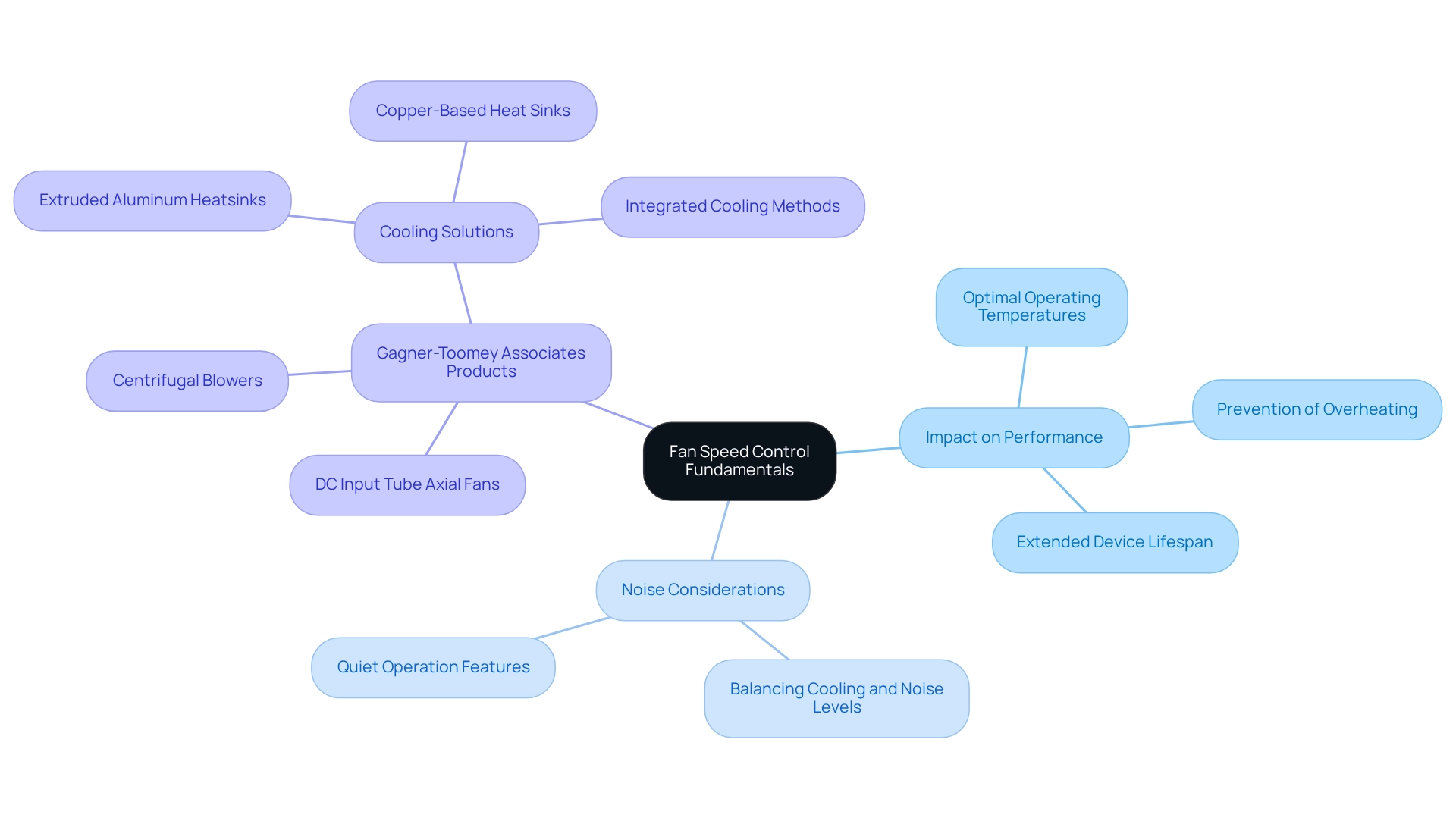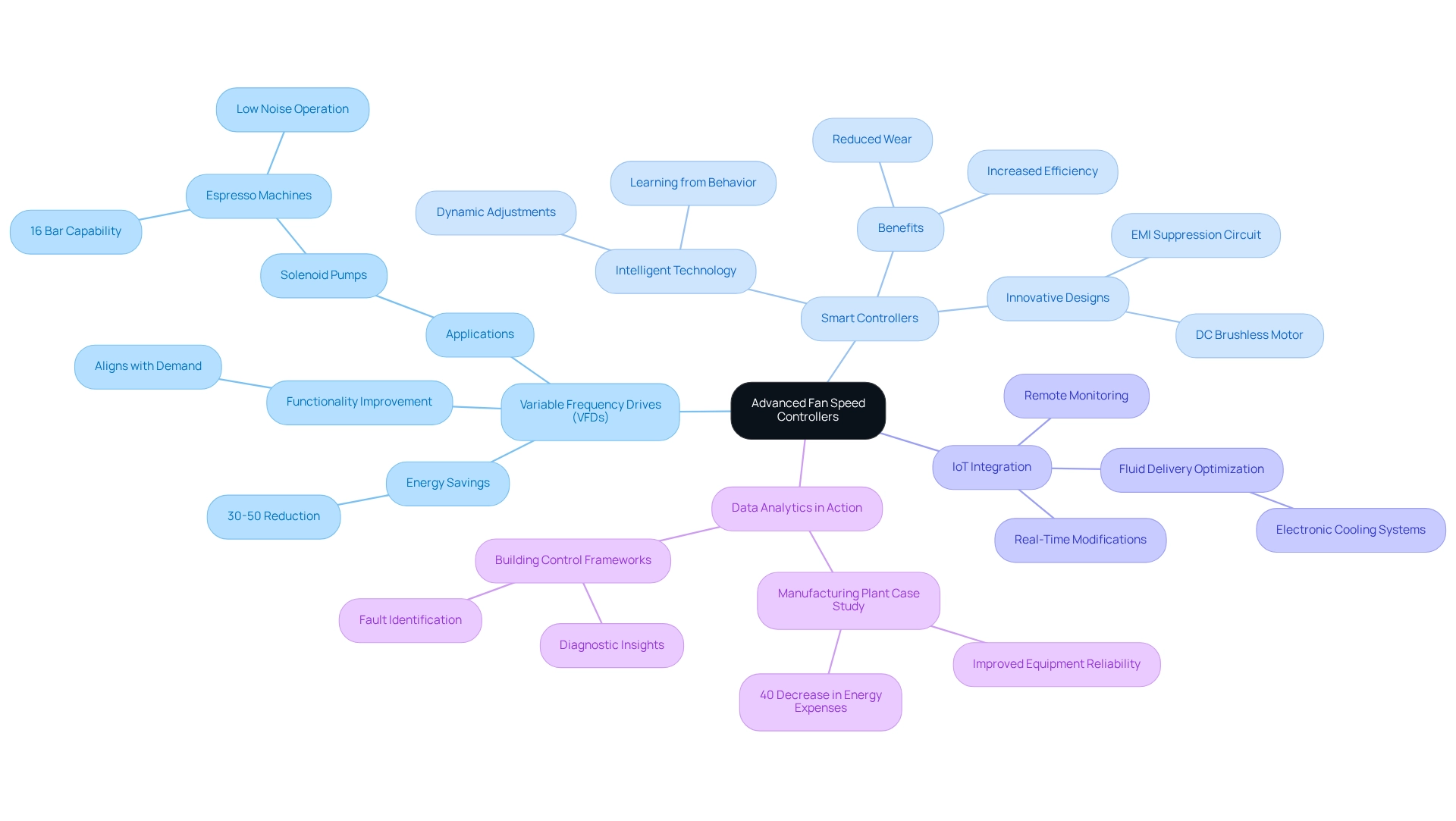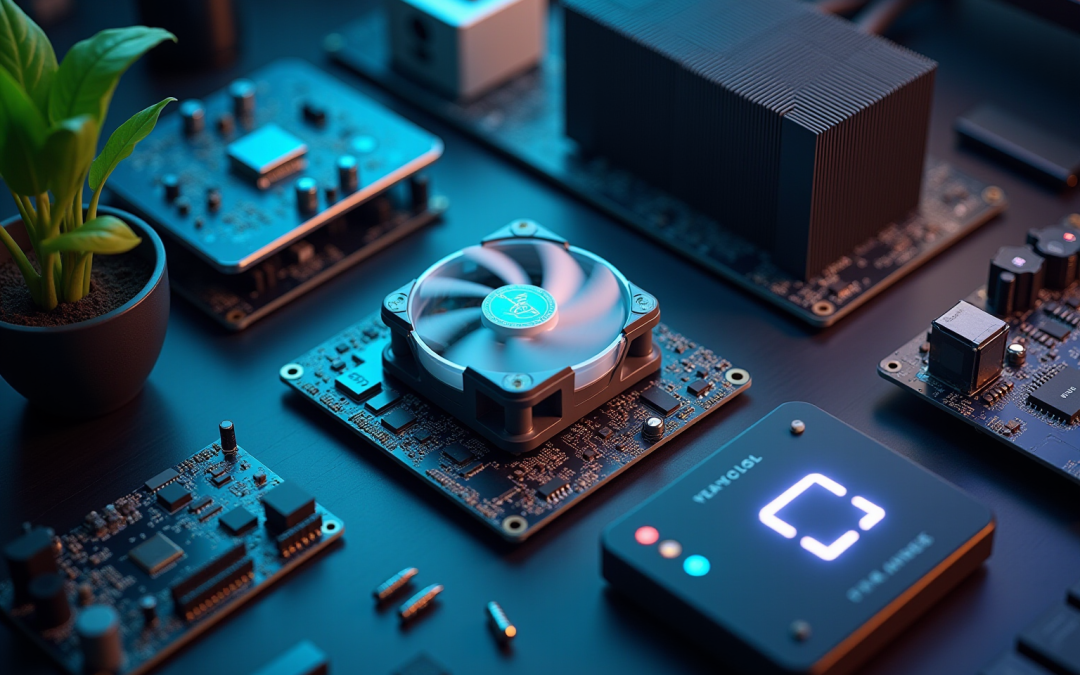Overview
The article presents four essential fan speed control techniques that optimize electronic performance:
- Pulse Width Modulation (PWM)
- Voltage regulation
- Thermal sensors
- Adaptive control systems
These methods not only enhance efficiency but also significantly reduce noise and improve thermal management. By demonstrating their critical role in preventing overheating, these techniques contribute to extending the lifespan of electronic devices, making them indispensable in modern electronics.
Introduction
In the realm of electronic systems, effective thermal management is paramount; fan speed control emerges as a critical component in this intricate equation. As technology advances, engineers face the challenge of optimizing airflow and cooling efficiency to enhance device performance and longevity. This article delves into the fundamentals of fan speed control, exploring various techniques such as:
- Pulse-width modulation
- Temperature-based adjustments
Additionally, it highlights the significance of integrating advanced controllers. Understanding these concepts is essential for anyone looking to leverage cutting-edge cooling solutions in today’s fast-paced technological landscape, from reducing energy consumption to minimizing noise levels.
Understand Fan Speed Control Fundamentals
Ventilator rotation regulation is essential for in electronic systems, as it entails modifying the rotational pace of ventilators to enhance airflow and cooling effectiveness. Grasping the fundamental principles of fan speed controls and operation management is crucial for engineers aiming to improve device performance and durability, particularly when employing advanced cooling solutions from Gagner-Toomey Associates, the globe’s largest producer of standard and custom air-movers for cooling applications. Each method offers distinct advantages tailored to specific applications, allowing for flexibility in design and implementation. Gagner-Toomey Associates provides a wide range of DC input tube axial fans and centrifugal blowers, varying from 15mm to 910mm, which can be efficiently combined with these management techniques.
- Impact on Performance: Efficient fan rotation management can significantly enhance the performance of electronic components by maintaining optimal operating temperatures. This proactive approach helps prevent overheating, which can lead to component failure, and significantly extends the lifespan of devices. Gagner-Toomey Associates’ cutting-edge cooling solutions, featuring extruded aluminum heatsinks, , and integrated cooling methods, further improve thermal management in electronics.
- Noise Considerations: The connection between fan rotation and noise levels is critical. Engineers must strike a balance between adequate cooling and acceptable noise levels to ensure user satisfaction, particularly in consumer electronics where noise can be a significant concern. Gagner-Toomey Associates enhances their products for quiet operation, rendering them suitable for delicate applications.
In conclusion, mastering fan rotation management principles is essential for engineers seeking to improve thermal regulation in electronic setups, guaranteeing both performance and reliability, especially when utilizing the advanced cooling solutions provided by Gagner-Toomey Associates.

Explore Effective Fan Speed Control Techniques
Effective fan speed control is crucial for optimizing electronic performance, and several techniques stand out in 2025:
- Pulse Width Modulation (PWM): This advanced method modulates the width of the pulses in a signal, allowing for precise control over the average power delivered to the fan. PWM technology not only enhances efficiency but also significantly reduces noise, making it a preferred choice in high-performance computing environments. As one expert noted, “What a difference! Couldn’t even tell the SC936 is turned on!” Its positive impact on operational costs and system stability reinforces its essential role in modern cooling strategies. The integration of PWM technology and is transforming , enhancing their efficiency and reliability like never before.
- Voltage Regulation: This simpler technique modifies the voltage provided to the fan to manage its pace. Although efficient, the fan speed controls can lead to inefficiencies at reduced rates, making it less appealing in situations that require accurate thermal management.
- Thermal Sensors: By incorporating thermal sensors, fan adjustments can be automated according to the temperature of essential components. This guarantees optimal cooling without the necessity for manual intervention, improving reliability.
- Adaptive Control Systems: Utilizing algorithms, these systems dynamically modify fan rates based on real-time data from temperature sensors. This not only optimizes performance but also improves energy consumption, making it a smart choice for modern electronic designs that utilize fan speed controls.
As emphasized in the case study named ‘PWM Fans vs. DC Fans: Key Differences and Applications,’ PWM fans, which employ a fourth wire for accurate rate adjustment, surpass conventional DC fans by offering improved thermal management and seizing a greater market share. Furthermore, ACDC FAN products achieve up to IP68 protection, making them well-suited for operation in challenging environments, further solidifying the advantages of these innovative cooling solutions.
Implement Temperature-Based Fan Speed Adjustments
Implementing temperature-based fan speed controls involves several key components that are essential for optimal performance in electronic devices:
- Sensor Integration: Temperature sensors are crucial for monitoring heat generated by electronic components. These sensors automatically activate fan speed controls when temperatures exceed predefined limits, ensuring effective cooling and preventing overheating. Additionally, developing effective management algorithms is vital for determining the appropriate fan speed controls based on real-time temperature measurements. For instance, a proportional regulation algorithm can dynamically adjust fan speed controls to increase velocity as temperatures rise, providing a responsive cooling solution. Notably, low-frequency PWM regulation is the predominant technique for managing fan speed controls in PCs, highlighting the importance of understanding industry best practices.
- Testing and Calibration: Regular evaluation and fine-tuning of the setup are necessary to ensure accurate fan speed controls in response to temperature fluctuations. This may involve adjusting sensor sensitivity and refining the fan response curve to achieve optimal performance. Additionally, incorporating capacitors or inductors in the PWM circuit can help reduce noise from fan vibrations, which is important for fan speed controls, as noted by Biswajit Das, manager – R&D at EFY Labs. A notable application of in a high-performance computing environment demonstrated significant benefits, achieving a 30% reduction in energy consumption while maintaining optimal operating temperatures. Furthermore, an IoT Temperature-Based Fan Speed Controls Management Framework illustrates how real-time temperature data can enhance energy efficiency, extend equipment lifespan, and improve operational ease across various settings, from residential to industrial environments. By leveraging these strategies, including the use of 4-wire fans essential for high-frequency PWM regulation techniques, engineers can effectively implement fan speed controls based on temperature modifications, resulting in improved performance and sustainability in electronic devices.
Leverage Advanced Fan Speed Controllers for Enhanced Performance
Advanced fan speed controllers significantly enhance performance through several innovative technologies:
-
Variable Frequency Drives (VFDs): These devices enable precise control of fan speed by adjusting the frequency of the power supply. This capability not only results in significant energy savings—often noted at approximately 30-50%—but also improves overall functionality by aligning fan rotation with actual demand. Furthermore, solenoid pumps, such as those provided by Gagner-Toomey Associates, can function effectively under comparable principles, offering accurate regulation in applications like espresso machines, with operational capabilities of up to 16 Bar and low noise operation.
-
Smart Controllers: By utilizing intelligent technology, these controllers can learn from operational behavior and historical data, enabling dynamic adjustments in fan speed controls. This adaptability ensures optimal performance under varying operational conditions, contributing to increased efficiency and reduced wear on equipment. As mentioned by David Hanrahan, “Superior thermal-management solutions are still being created and provided to the computing sector by Analog Devices,” emphasizing the significance of advanced regulation technologies in electronics. Gagner-Toomey Associates also excels in offering rotary boost pumps that improve performance through innovative design, incorporating a DC Brushless motor and EMI suppression circuit.
-
Integration with IoT: Advanced fan controllers can seamlessly connect with IoT networks, facilitating remote monitoring and control. This integration enables real-time modifications according to environmental factors, ensuring that operations function at optimal efficiency while reducing energy usage. Similarly, the integration of solenoid pumps in IoT applications can optimize fluid delivery in various electronic cooling systems.
-
Data Analytics in Action: A significant application included a manufacturing plant that utilized intelligent fan controllers modifying rates according to real-time information from various sensors. This strategic move led to a remarkable 40% decrease in energy expenses and improved equipment reliability, highlighting the tangible advantages of advanced fan speed controls technologies. Furthermore, the trend of data analytics in building control frameworks emphasizes the significance of managing and analyzing data to evaluate performance and efficiency.
-
Practical Application: To effectively implement these technologies, engineers should consider the following steps:
- Evaluate current fan setups and pinpoint possible areas for enhancement.
- Capture nameplate data from motors and input it into a spreadsheet to explore potential savings.
- Evaluate the integration of VFDs and smart controllers based on specific operational needs.
- Monitor performance metrics post-implementation to ensure desired outcomes are achieved.
For more information on solenoid and rotary boost pumps, including specifications and to find a distributor, please visit our product website. The ongoing advancements in variable frequency drives and smart controllers are set to redefine in 2025 and beyond, making them essential components in modern electronic systems, alongside innovative pump technologies from Gagner-Toomey Associates.

Conclusion
Effective thermal management through fan speed control is not just beneficial; it is essential for optimizing the performance and longevity of electronic systems. This article has examined the core concepts of fan speed control, delving into techniques such as:
- Pulse-width modulation (PWM)
- Voltage regulation
- Temperature-based adjustments
Each method presents distinct advantages tailored to specific applications, empowering engineers to enhance cooling efficiency while minimizing noise levels.
The integration of advanced fan speed controllers, including variable frequency drives and smart controllers, has revolutionized cooling solutions. These technologies not only bolster energy efficiency but also facilitate real-time adjustments based on system demands, resulting in substantial cost savings and improved reliability. Moreover, the implementation of temperature sensors alongside automated control algorithms guarantees that cooling remains both responsive and effective, effectively preventing overheating and prolonging the lifespan of critical components.
In conclusion, mastering fan speed control is crucial for engineers who aspire to leverage cutting-edge cooling solutions in today’s rapidly evolving technological landscape. By comprehending and applying these techniques, professionals can optimize thermal management, enhance device performance, and contribute to the development of more sustainable electronic systems. As advancements continue to redefine the future of cooling technologies, embracing these innovations will be vital for achieving optimal outcomes in electronic design and application.
Frequently Asked Questions
Why is ventilator rotation regulation important for electronic systems?
Ventilator rotation regulation is essential for efficient thermal management as it modifies the rotational pace of ventilators to enhance airflow and cooling effectiveness, which is crucial for maintaining optimal operating temperatures in electronic components.
How does effective fan rotation management impact device performance?
Efficient fan rotation management significantly enhances electronic component performance by preventing overheating, which can lead to component failure, and helps to extend the lifespan of devices.
What types of cooling solutions does Gagner-Toomey Associates offer?
Gagner-Toomey Associates provides a wide range of cooling solutions, including DC input tube axial fans and centrifugal blowers, with sizes varying from 15mm to 910mm, as well as advanced cooling options featuring extruded aluminum heatsinks and copper-based heat sinks.
What considerations should engineers keep in mind regarding noise levels?
Engineers must balance adequate cooling with acceptable noise levels, especially in consumer electronics, where noise can significantly affect user satisfaction. Gagner-Toomey Associates enhances their products for quiet operation to suit delicate applications.
What is the overall significance of mastering fan rotation management principles?
Mastering fan rotation management principles is crucial for engineers to improve thermal regulation in electronic setups, ensuring both performance and reliability, particularly when utilizing advanced cooling solutions provided by Gagner-Toomey Associates.

